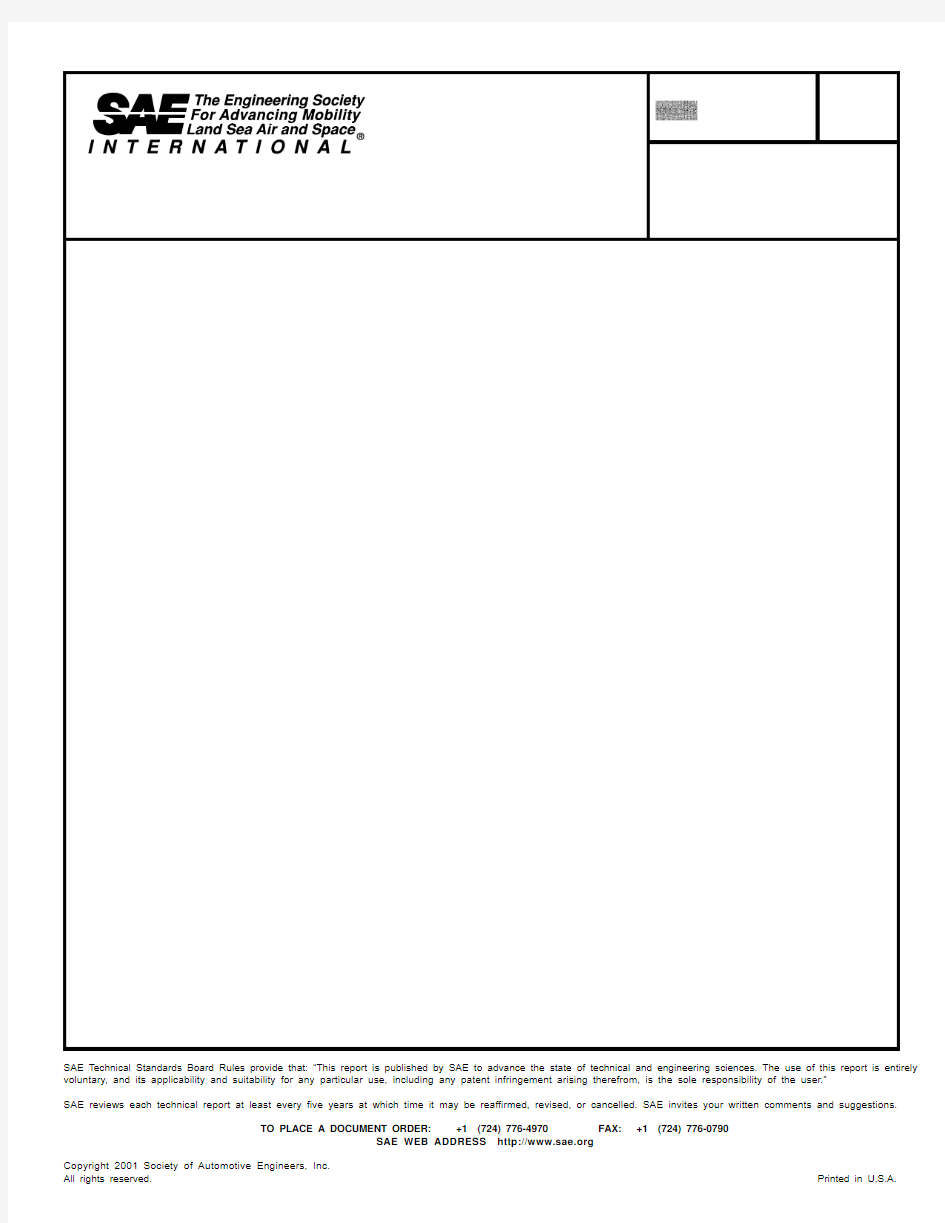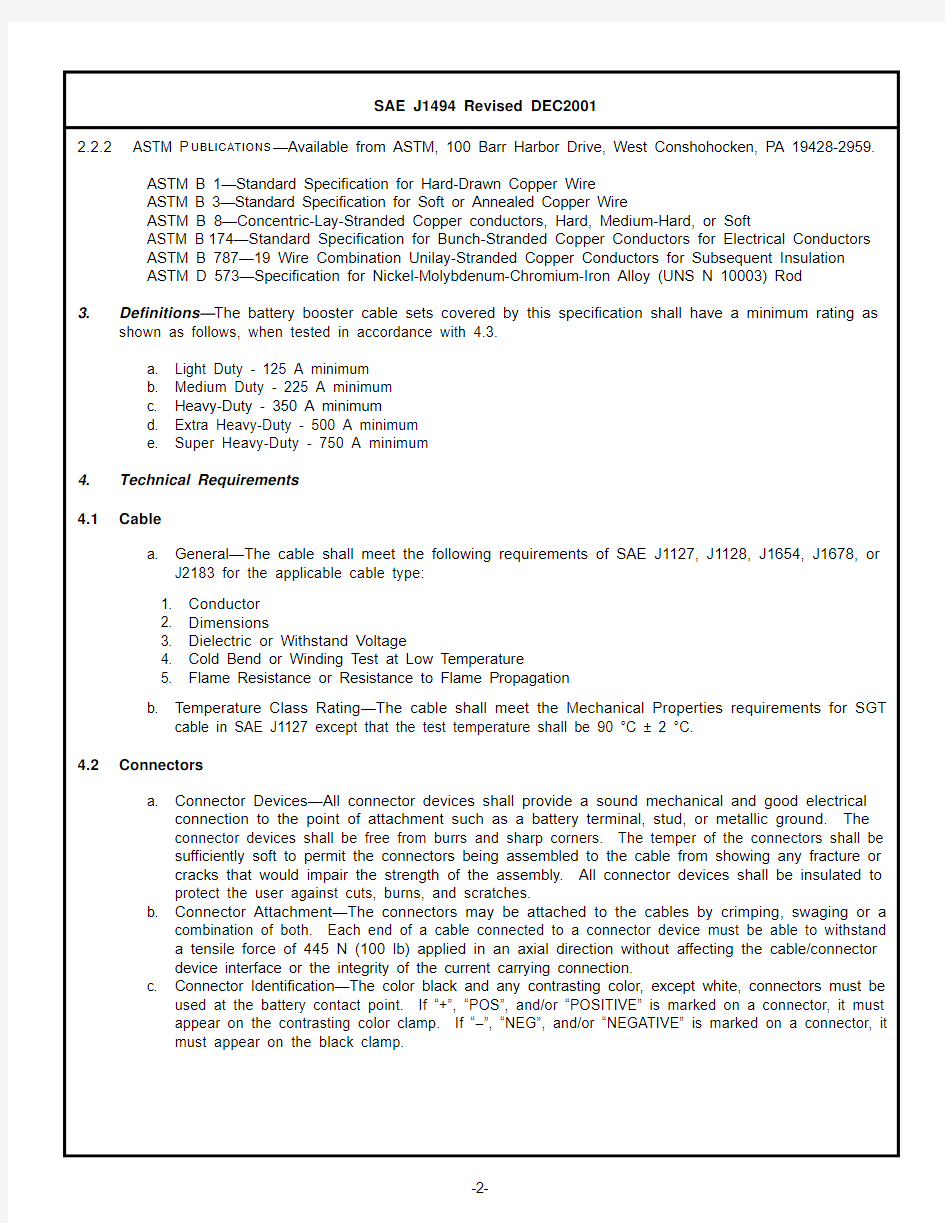SAE J1494-2001 电池升压器电缆


SAE Technical Standards Board Rules provide that: “This report is published by SAE to advance the state of technical and engineering sciences. The use of this report is entirely voluntary, and its applicability and suitability for any particular use, including any patent infringement arising therefrom, is the sole responsibility of the user.”
SAE reviews each technical report at least every five years at which time it may be reaffirmed, revised, or cancelled. SAE invites your written comments and suggestions.
TO PLACE A DOCUMENT ORDER: +1 (724) 776-4970 FAX: +1 (724) 776-0790
SAE WEB ADDRESS https://www.wendangku.net/doc/913179581.html,
Copyright 2001 Society of Automotive Engineers, Inc.
2.2.2ASTM P UBLICATIONS—Available from ASTM, 100 Barr Harbor Drive, West Conshohocken, PA 19428-2959.
ASTM B 1—Standard Specification for Hard-Drawn Copper Wire
ASTM B 3—Standard Specification for Soft or Annealed Copper Wire
ASTM B 8—Concentric-Lay-Stranded Copper conductors, Hard, Medium-Hard, or Soft
ASTM B174—Standard Specification for Bunch-Stranded Copper Conductors for Electrical Conductors
ASTM B 787—19 Wire Combination Unilay-Stranded Copper Conductors for Subsequent Insulation
ASTM D 573—Specification for Nickel-Molybdenum-Chromium-Iron Alloy (UNS N 10003) Rod
3.Definitions—The battery booster cable sets covered by this specification shall have a minimum rating as
shown as follows, when tested in accordance with 4.3.
a.Light Duty - 125 A minimum
b.Medium Duty - 225 A minimum
c.Heavy-Duty - 350 A minimum
d.Extra Heavy-Duty - 500 A minimum
e.Super Heavy-Duty - 750 A minimum
4.Technical Requirements
4.1Cable
a.General—The cable shall meet the following requirements of SAE J1127, J1128, J1654, J1678, or
J2183 for the applicable cable type:
1.Conductor
2.Dimensions
3.Dielectric or Withstand Voltage
4.Cold Bend or Winding Test at Low Temperature
5.Flame Resistance or Resistance to Flame Propagation
b.Temperature Class Rating—The cable shall meet the Mechanical Properties requirements for SGT
cable in SAE J1127 except that the test temperature shall be 90 °C ± 2 °C.
4.2Connectors
a.Connector Devices—All connector devices shall provide a sound mechanical and good electrical
connection to the point of attachment such as a battery terminal, stud, or metallic ground. The
connector devices shall be free from burrs and sharp corners. The temper of the connectors shall be
sufficiently soft to permit the connectors being assembled to the cable from showing any fracture or
cracks that would impair the strength of the assembly. All connector devices shall be insulated to
protect the user against cuts, burns, and scratches.
b.Connector Attachment—The connectors may be attached to the cables by crimping, swaging or a
combination of both. Each end of a cable connected to a connector device must be able to withstand
a tensile force of 445 N (100 lb) applied in an axial direction without affecting the cable/connector
device interface or the integrity of the current carrying connection.
c.Connector Identification—The color black and any contrasting color, except white, connectors must be
used at the battery contact point. If “+”, “POS”, and/or “POSITIVE” is marked on a connector, it must
appear on the contrasting color clamp. If “–”, “NEG”, and/or “NEGATIVE” is marked on a connector, it
must appear on the black clamp.
4.3Current Rating—The following procedure should be performed at an ambient temperature of 23 °C ± 5 °C
(73°F ± 9 °F) in order to determine the battery booster cable set rating as shown in Section 3.
a.Recommended Equipment
1.Source of constant DC current with sufficient capacity to allow a
2.5 V minimum drop on each cable
with a current measuring capability of ±1% accuracy.
2.Stainless steel electrodes per Figure 1 attached to current source electrodes.
3.Voltmeter (accurate to 0.01 V).
4.Timing device.
5.Thermocouple (iron/constantan type).
6.Chart recorder with 121 °C ± 3 °C (250 °F ± 5 °F) maximum reading accurate to 0.25% full scale.
b.Test Procedure
1.Attach one of the cables of the battery booster cable set to the current source by clamping to the
stainless steel electrode area A (see Figure 1) in the manner the clamps would normally be used.
2.Attach the thermocouple to the battery booster cable clamp handle by taping tightly to the outer
surface at a mid-point between the pivot and the rear of the current carrying clamp. If nonpermanent
attached grips are used, slide the grip off the handle and apply thermocouple directly to the handle.
NOTE—(Thermocouple is attached in an area normally gripped by the user). Attach the other end of the thermocouple lead to the chart recorder.
3.Select a test current and apply to the cable.
4.After 10 s, measure and record the voltage drop from one stainless steel electrode to the other.
5.After 15 s, turn off the current.
6.Monitor the temperature of the handle for an additional 2 min and record the maximum temperature.
The maximum temperature permitted is 66 °C (150 °F).
NOTE—Some clamps will be at a maximum temperature immediately after the current is turned off, others will continue to rise for various periods.
7.Repeat steps 1 through 6 with the other cable of the battery booster cable set.
8.Repeat steps 1 through 7 with successive greater test currents until the test current produces a
combined total voltage drop of 5.0 V for both cables in the battery booster cable set. The cables
should be allowed to cool for approximately 15 min before retesting.
9.Repeat steps 1 through 8 with the battery booster cable clamp attached to area B (see Figure 1) of
the stainless steel electrode.
https://www.wendangku.net/doc/913179581.html,ing the test data from area A and B, determine the largest of the test currents that does not cause
a combined total voltage drop of more than 5.0 V or a temperature of more than 66 °C (150 °F) on
the handle. The rating of the cable set shall be the lowest amperage rating of the results of tests
performed using Clamping Area A and Clamping Area B.
FIGURE 1—STAINLESS STEEL ELECTRODE
https://www.wendangku.net/doc/913179581.html,beling Information
5.1Tags—The following information must be affixed to the battery booster cable set and should be printed on a
material that is capable of withstanding abuse during normal usage:
a.Instructions for Jump Starting an Engine:
WARNING—Batteries Contain Acid and Produce Explosive Gases
NOTE—Consult the owner's manual for complete instructions. SHIELD THE EYES AND FACE FROM THE BATTERIES AT ALL TIMES. Be sure the vent caps are tight and level. Place a damp cloth, if
available, over any vent caps on both batteries. Be sure the vehicles do not touch and that both
electrical systems are off and at the same voltage. These instructions are for negative ground
systems only.
1.Connect the positive (+) cable to the positive (+) terminal of the discharged battery that is wired to
the starter or solenoid.
2.Connect the other end of the positive cable to the positive terminal of the booster battery.
3.Connect the black negative (–) cable to the other terminal (negative) of the booster battery.
4.MAKE THE FINAL CONNECTION ON THE ENGINE BLOCK OF THE STALLED VEHICLE (NOT
TO THE NEGATIVE POST) AWAY FROM THE BATTERY. STAND BACK.
5.Start the vehicle and remove the cables in the reverse order of connection (the engine block (black)
connection is the first to disconnect).
5.2Packaging—The tag information, see 5.1, must appear on the package in addition to the following warnings
and safety procedures:
a.Battery Booster Cable Instructions for Jump Starting an Engine:
WARNING—Batteries Contain Acid and Produce Explosive Gases.
These instructions are designed to minimize the explosion hazard. Keep sparks, flames, and
cigarettes away from the batteries at all times. Wear safety glasses, and protect the eyes at all times.
Do not lean over the batteries during this operation.
Both the battery to be jumped and the booster source must be of the same voltage (6 or 12 V, etc.).
Power sources other than batteries should not exceed 16 V DC for use with 12 V systems, and 8 V DC
for use with a 6 V DC system.
Position the vehicle with the booster battery, or other power source, adjacent to the vehicle with the
discharged battery so that booster cables can be connected easily between both vehicles. Make
certain that the vehicles do not touch each other.
1.Turn off all electrical loads on all vehicles and set the parking brake. Place the automatic
transmissions in “PARK” (manual transmission in “NEUTRAL”).
2.Determine whether the discharged battery has the negative (–) or the positive (+) terminal connected
to the ground. The ground lead is connected to the engine block, the vehicle frame, or some other
good metallic ground. The battery terminal connected to the starter is the one that is not grounded. All
vehicles manufactured in the U.S.A. after 1955 have the negative battery terminal grounded. All
European and Asian passenger vehicles manufactured after 1971 have the negative battery terminal
grounded.
3.On a negative ground system, connect the positive (+) cable to the positive (+) terminal of the
discharged battery wired to the starter or solenoid. Do not allow the positive cable clamps to touch any
metal other than the battery positive (+) terminals.
4.Be sure that the vent caps are tight and level on both batteries. Place a damp cloth over any vent caps
on each battery making certain it is clear of fan blades, belts, and other moving parts.
5.3Supplemental Packaging Information—Additional supplemental information and instructions may also be
included.
6.Notes
6.1Marginal Indicia—The change bar (l) located in the left margin is for the convenience of the user in locating
areas where technical revisions have been made to the previous issue of the report. An (R) symbol to the left of the document title indicates a complete revision of the report.
PREPARED BY THE SAE ELECTRICAL DISTRIBUTION SYSTEMS STANDARDS COMMITTEE
Rationale—This Recommended Practice was revised to require cable used in battery booster cables be in compliance with applicable SAE Standards. The scope was clarified to indicate that this document applies only to battery booster cables for 6 and 12-Volt batteries. Also, revisions were made to comply with the latest version of the SAE Technical Standards Board format.
Relationship of SAE Standard to ISO Standard—Not applicable.
Application—The purpose of this SAE Recommended Practice is to establish minimum performance and user information requirements for battery booster cable sets used with 6 OR 12-VOLT BATTERIES. Such sets may be used to provide a temporary connection of a surface vehicle battery to another similar battery to provide emergency power when required. This document DOES NOT ENDORSE NOR RECOMMEND the potentially hazardous procedure of jump-starting a vehicle.
Reference Section
SAE J156—Fusible Links
SAE J1067—Seven Conductor Jacketed Cable for Truck Trailer Connections
SAE J1127—Battery Cable
SAE J1128—Low Tension Primary Cable
SAE J1292—Automobile, Truck, Truck-Tractor, Trailer, and Motor Coach Wiring
SAE J1654—High Voltage Primary Cable
SAE J1673—High Voltage Automotive Wiring
SAE J1678—Ultra Thin Wall Primary Cable
SAE J2183—60 V and 600 V Single Core Cables—Test Methods, Dimensions and Requirements
SAEJ2501—Round, Unscreened, 60 V and 600 V Multicore Sheathed Cables—Basic and High Performance Test Methods and Requirements
SAE Dictionary of Materials and Testing
ASTM B 1—Standard Specification for Hard-Drawn Copper Wire
ASTM B 3—Specification for Soft or Annealed Copper Wire
ASTM B 8—Concentric-Lay-Stranded Copper conductors, Hard, Medium-Hard, or Soft
ASTM B 33—Specification for Tinned Soft or Annealed Copper Wire for Electrical Purposes
ASTM B 174—Standard Specification for Bunch-Stranded Copper Conductors for Electrical Conductors ASTMB189—Specification for Lead-Coated and Lead-Alloy-Coated Soft Copper Wire for Electrical Purposes
ASTM B 787—19 Wire Combination Unilay-Stranded Copper Conductors for Subsequent Insulation ASTM D 573—Specification for Nickel-Molybdenum-Chromium-Iron Alloy (UNS N 10003) Rod Developed by the SAE Electrical Distribution Systems Standards Committee
